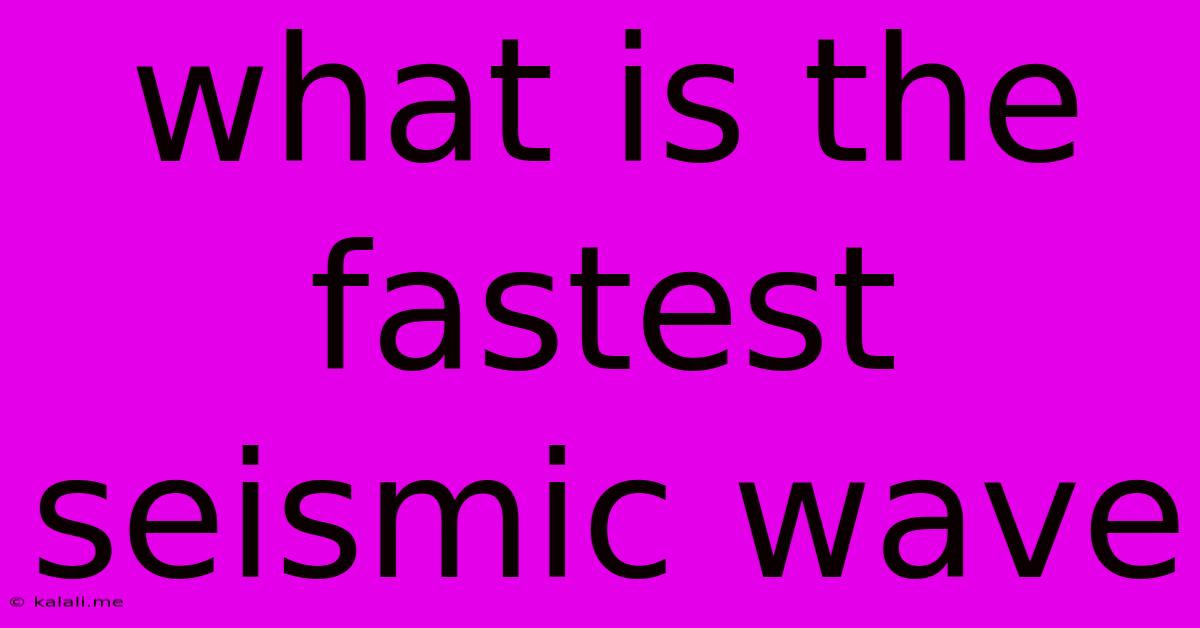What Is The Fastest Seismic Wave
Kalali
May 09, 2025 · 3 min read

Table of Contents
What is the Fastest Seismic Wave? Understanding P-Waves and Earthquake Propagation
Earthquakes, those powerful and sometimes devastating events, release energy in the form of seismic waves that travel through the Earth's interior. Understanding these waves is crucial for seismologists to locate earthquakes, study the Earth's structure, and develop early warning systems. This article will delve into the fastest seismic wave, explaining its properties and importance in earthquake science.
The answer is simple: P-waves (Primary waves) are the fastest seismic waves. They travel significantly faster than other seismic waves, reaching monitoring stations first and providing crucial early warning information.
Understanding Seismic Waves: A Quick Overview
Seismic waves are broadly classified into two main types: body waves and surface waves. Body waves travel through the Earth's interior, while surface waves travel along the Earth's surface. Within body waves, we have:
-
P-waves (Primary waves): These are longitudinal waves, meaning the particle motion is parallel to the direction of wave propagation. Think of a slinky being pushed and pulled – the compression and rarefaction of the slinky mimics the movement of particles in a P-wave. This compressional nature allows them to travel through solids, liquids, and gases.
-
S-waves (Secondary waves): These are transverse waves, meaning the particle motion is perpendicular to the direction of wave propagation. Imagine shaking a rope up and down – the wave travels along the rope, but the rope itself moves up and down. S-waves only travel through solids because liquids and gases cannot support shear stress.
Surface waves, including Love waves and Rayleigh waves, are slower than both P-waves and S-waves but are responsible for the most significant ground shaking during an earthquake.
Why are P-waves the Fastest?
The speed of a seismic wave depends on the properties of the material it travels through, primarily the material's density and elasticity (its resistance to deformation). P-waves, due to their compressional nature, can more efficiently transmit energy through the material. The compression and rarefaction process facilitates faster energy transfer compared to the shearing motion of S-waves.
This difference in speed is significant. P-waves typically travel about 1.7 times faster than S-waves in the Earth's crust. This speed difference is crucial for earthquake location and early warning systems.
The Importance of P-wave Speed in Earthquake Monitoring
The speed advantage of P-waves is instrumental in several aspects of earthquake monitoring:
-
Earthquake Location: Seismologists use the time difference between the arrival of P-waves and S-waves at different seismograph stations to precisely locate the earthquake's epicenter. The greater the time difference, the farther the station is from the epicenter.
-
Early Warning Systems: The significant speed difference allows for early warning systems. Detecting the arrival of P-waves at a seismic station can provide a few seconds to several tens of seconds of warning before the arrival of more destructive S-waves and surface waves, potentially allowing for immediate protective actions.
-
Understanding Earth's Interior: The variations in P-wave speeds at different depths provide critical information about the Earth's internal structure, composition, and temperature. These variations can reveal changes in material properties, like the transition between the Earth's mantle and core.
In conclusion, P-waves are the fastest seismic waves due to their compressional nature and efficient energy transmission. Their speed is critical for earthquake location, early warning systems, and understanding the Earth's intricate internal structure. Further research continues to refine our understanding of seismic wave propagation and its implications for earthquake preparedness and hazard mitigation.
Latest Posts
Latest Posts
-
Prevent An Expressway Emergency By Merging Without
Jul 12, 2025
-
How Many Grams Of Sugar In A Pound
Jul 12, 2025
-
7am To 11am Is How Many Hours
Jul 12, 2025
-
If Your 35 What Year Was You Born
Jul 12, 2025
-
How Many Cups Is 1 Pound Of Cheese
Jul 12, 2025
Related Post
Thank you for visiting our website which covers about What Is The Fastest Seismic Wave . We hope the information provided has been useful to you. Feel free to contact us if you have any questions or need further assistance. See you next time and don't miss to bookmark.